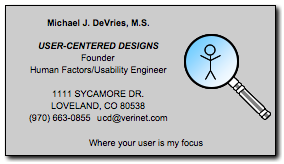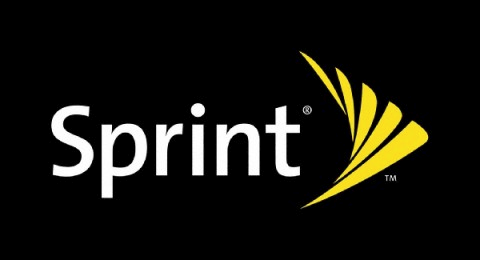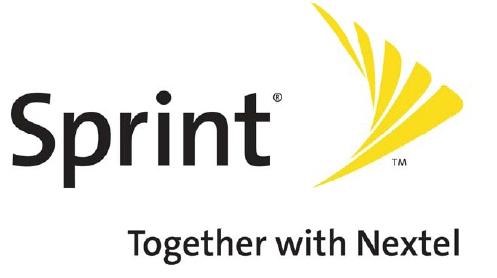|
|

|
Quick Work History
- 2006 to 2009: Competitive User Experience Lead, serving 23 organizations by the end of the 2nd year.
- 2000 to 2005: Usability Lab Lead, with over 40 usability studies/reviews including the 1st wireless 3G launch.
- 2000 to 2007: Director of a volunteer organization. Infused UI design into program materials and processes.
- 1999 to 2000: Sole proprietor, usability consultant serving Fortune 500 companies.
- 1996 to 1999: Usability specialist, working primarily with HP.
|
|
|
|

|
It All Started Here

|

My Major: I chose to study Psychology because I had always been interested in how people think and behave. Math challenged me, and I liked that, so I minored in it. I liked statistics in particular, which fit well with my Psych major.
How I Learned about Human Factors: One day in Experimental Psych class, while doing research on mental rotation, I realized it might have military implications. A few questions later, I found out about human factors, and that there was an opportunity to work at the Air Force Base for college credit. I jumped on it, and my foray into the world of researching user experiences began.
|

|

Air Force Operational Test & Evaluation Center
|
My First Human Factors Job: At age 21, I found myself on the flight lines of Edward's AFB working with the F-15E, right before Desert Storm. My job was to improve the reliability and validity of mental workload assessments, and identify critical usability issues.
|

|

|
B.S. in Psychology at UNT: I transferred to UNT to learn more about Psychology in the workplace. After taking my stats class, my interest in human factors as a career solidified. I also learned that I still enjoyed leading groups, a characteristic that came naturally in high school where I had been president of a few clubs and captain of the soccer team my senior year. I lead a study group at UNT for botany that packed a room. I graduated with a 3.75 on a 4.0 scale.
|

|

|
M.S in Psychology - Human Factors Opion at U of I.: At Idaho, I developed research and design skills for user interfaces that ranged from software to medical devices to snowmobiles. I graduated with a 3.76 on a 4.0 scale, and believed I would head right back to the position in Albuquerque, NM with the Air Force Operational Test & Evaluation Center. instead, I finished my thesis and headed to Colorado to work with an independent consulting group.
Thesis Work: I did my thesis work on Cognitive Complexity. Northrup Grumman wanted assistance knowing which tasks, among many, were more cognitively complex than others so that they would know what tasks were better suited for using cognitive tasks analysis rather than the standard task analysis. The goal was to develop software that assisted in the estimation of different parts of the task knowledge base. It was like estimating the number of bricks in a fireplace v. a house v. a building. To estimate the knowledge base, we estimated the number of Strategies, Concepts, Rules, Patterns, and Steps of a task. Assuming that the inference and higher order cognitive processing are proportionally equal to size of the knowledge base, estimating the size of the knowledge base would be a predictor of the level of cognitive complexity.
I still use this principle today when considering the tasks I need to design and research.

|

|

|
Small Market Research and Usability Company: I was very fortunate to find myself at Lodestone Research in Loveland, Colorado. The company joined Market Research with Usability Design and Research. The focus was to always to keep an eye on the "so what" of what we were doing, both for the customer and business. While there, I participated in the design and lead the research efforts for the HP CapShare, a handheld scanner.
|

|

|
Sole-Proprietor and Usability Consultant: After leaving Lodestone, I worked for myself for a short time. I consulted for Storage Tek on software solutions and then ran focus groups and developed design concepts for the Trane Company.
6 Month Usability Contract at Intel: Working in Intel's IT department, I ran usability studies and evaluated designs. I found I even enjoyed working on how e-mails were designed. Anything to make a poor experience better. With the contract complete, I headed back to Colorado. Shortly after returning, SprintPCS.com called.
|

|



|
User Experience Lead at Sprint.com: At SprintPCS.com, I lead a developer, graphics artist, and content designer in the research and design of an online Shopper's Guide. The Guide assisted online shopper in navigating the complex waters of purchasing a wireless phone and its associated plan. When the project was complete, the customer purchase close rate exceeded the company's expectations for the project.
User Experience Researcher at Sprint.com: Having identified a gap in the team's approach to testing with theShopper's Guide project, I became the research lead and created and managed a low budget usability lab. I recruited, worked with external recruiters, planned and executed on a wide range of study methodologies, delivered reports, and applied the results to improve on existing designs.
User Experience Researcher at Sprint: SprintPCS.com was eventually absorbed by Sprint. I continued lab research for a short time on produces such as the web, wireless phones, and even customer paper bills. I also expanded out of the lab, conducting contextual inquiries and conducting in-store research of customer wait times.
Competitive Usability Program Lead at Sprint-Nextel: Shortly after the Sprint Nextel merger, I was assigned to create a competitive usability program to advise designers and program managers on the competitive mobile user experiences. In just over two years, I was supporting over 20 functional groups, including Legal, Advertising, and Executive teams.
|
|